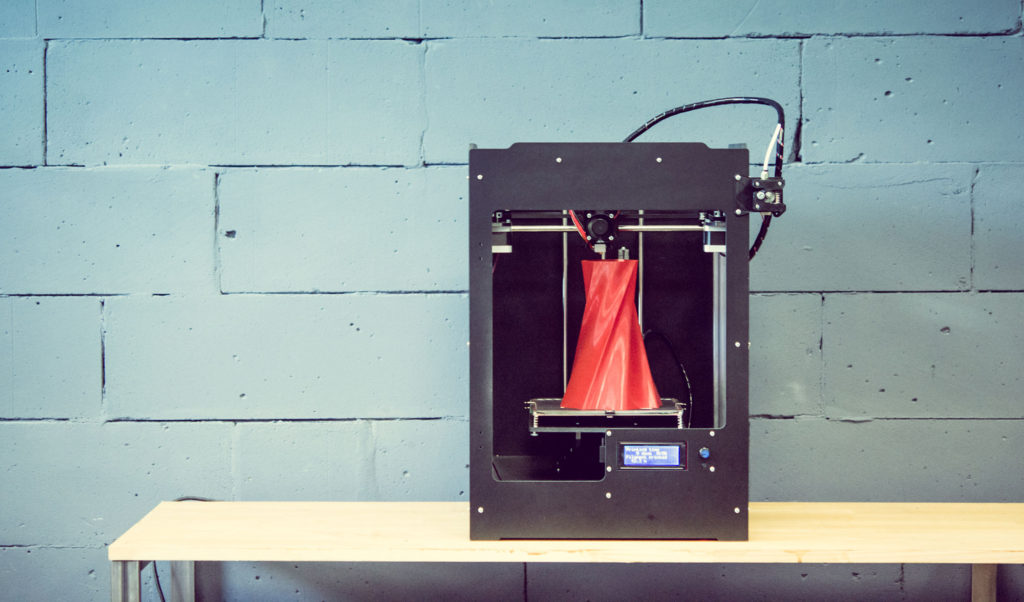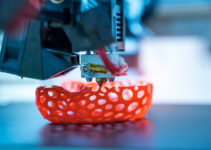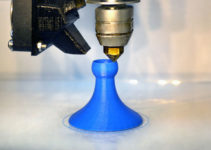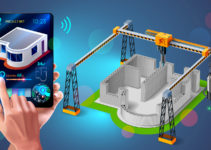IN A HURRY? CHECK OUT Qidi Tech X-Pro 3D-Printer TOP PROS:
If you’re new to the world of 3D printers, the first thing you’ll notice is how expensive some of the most popular 3D printers are. A high-end, well-constructed, and reliable consumer 3D printer will cost you a pretty penny. However, if you want to try out the technology, there are lots of options out there that won’t cost you a leg, an arm, and your firstborn child. In this article, we’re going to go over the best 3D printers under $500.
This article is divided into two sections. The first section is a super condensed 3D printers buying guide, and the second is a list of the best 3D printers you can find under five hundred dollars. If you’re looking for a detailed guide, you can check out our other articles. So let’s jump into it!
CONTENTS:
| IMAGE | PRODUCT | DETAILS | |
|---|---|---|---|
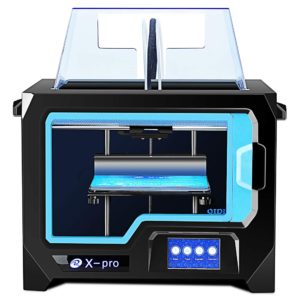 |
Our #1 Choice
Qidi Tech X-Pro 3D-Printer |
|
Check on Amazon |
 |
FlashForge Finder 3D |
|
Check on Amazon |
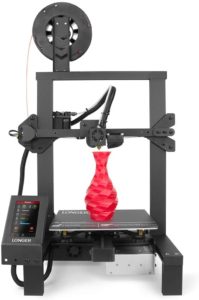 |
LK4 Pro 3D Printer |
|
Check on Amazon |
 |
Creality Ender 3 |
|
Check on Amazon |
How To Buy A 3D Printer: A Short Guide
In this guide, we’ll give you a quick rundown on what you should look out for before buying a 3D printer. This guide will greatly help you choose the printer that best suits your needs. It will also help you avoid buying a low-quality 3D printer.
Materials
It is important to note that 3D printing takes place when you heat a plastic filament to the point that it is malleable. After this, the 3D printer remodels this filament in the shape that you programmed. What’s most important about this process is the materials, in this case, filaments. There are various filament materials available, and different printers use different types.
The most common filaments are PLA and ABS. PLA plastic is an excellent printing material because it has a low melting point, and it’s relatively cheap. Unfortunately, because of its low melting point, PLA objects will deform in direct sunlight. ABS, on the other hand, is very durable and has a higher melting point. Additionally, you can use acetone vapor to give your 3D printed models a beautiful glossy look. There are other materials that 3D printers can use, but we’re not going to talk about them because almost all 3D printers under $500 use one of these two materials.
Build Area
The build area is one of the most important factors you should consider before you buy a 3D printer. Build area refers to the maximum size of the object you can print on a particular 3D printer. 3D printers come in various sizes and shapes, which means they have different build areas. Some of them might have a wider or taller build area compared to others.
You will have to rotate and scale 3D models according to the build area of your 3D printer. If that seems like too much of a hassle for you, you can buy a printer that has a big build area. However, you need to keep in mind that big build area means a high price tag. We recommend you try and strike a balance between saving money in the long run and being able to create huge items.
Print Speed
Even though 3D printers have come a long way in the last decade, they still operate slowly. In general, budget printers operate at a rate of 50 millimeters per second. However, a fast printing 3D printer might mess up the final product because it won’t apply the correct amount of material to the layer. Therefore, slower printers are a better option in a way.
Some models come with an extra extrusion nozzle that helps speed up the printing process. This type of printer offers you the advantage of printing with multiple materials simultaneously. However, extra nozzles mean extra cash.
We know it’s not easy to find a good 3D printer and we hope that the following list of best 3D printers under $500 will help you make a decision.
The 4 Best 3D Printers Under $500
Very few people need a thousand dollar 3D printer. If you’re new to the technology and you’re looking for something that will help you learn more about how 3D printers work, then the models listed below are a good starting point.
Even if money is not an issue for you, we advise you to start out small with one of the cheaper kits listed below. If the need for a bigger and better 3D printer arises, you can always upgrade to one of the better 3D printers available. By opting for a cheaper 3D printer, you can ensure you like the technology enough to where you can justify spending more on a top-of-the-shelf model.
1. Qidi Tech X-Pro 3D-Printer

Are you looking for a 3D printer under $500? This is one of the very best printers you’ll see in the tech market. It is quite popular among users. The package dimensions are 22.8in (L) × 21.1in (W) × 18.5in (H). Item weight is 39.6 pounds.
This product is equipped with the latest dual extrusion technology. This printer can be easily used in various fields of study like engineering, education, and hobby printing. X-Pro 3D printer has a breakaway point feature that allows you to take a break while printing and you can resume printing when you’re ready.
The printer is equipped with a strong metallic support rod to achieve stability while printing. This wonderful printer has a 4.3-inch touchscreen with a large and user-friendly interface. This contributes significantly to the overall printing experience. It provides printing status in real-time. It’s very easy to operate, you don’t need to be a techy person to operate the 3D printing machine.
What caught our attention most is the product tech service. If you’re having difficulties setting up your printer or there are queries you have, the tech service is always on the ground to answer your queries, and help you with any difficulty.
Pros
- Power breaking point function: a breakpoint can be saved and printing can be resumed later
- Slicing software: it has a special auto slice software that can be configured based on your time and preferences
- 4.3 touch screen with a large screen and user-friendly interface
Cons
- It is difficult to get materials off the magnetic base plate
Bottom line
This printer is the most cost-effective 3D printer with dual extrusion you would find in the tech market. Setting up the printer is easy and simple. You need approximately 30 mins to set it up, from unboxing it to the first print.
The printer also comes with some extra tools and nozzles. The service support for this printer is outstanding. You’ll always get a response to queries and questions you might have. Overall, it’s a wonderful 3D printer.
2. FlashForge Finder 3D
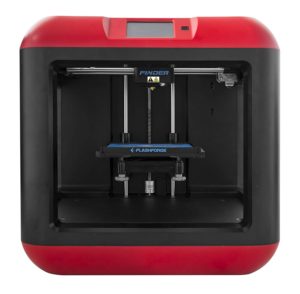
The FlashForge Finder 3D is an excellent little 3D printer that is perfect for novices, families, and schools. This affordable little printer is extremely user-friendly and features a sleek design that conceals the cables from sight within a plastic alloy body.
Unlike the previous 3D printer we showcased, FlashForge Finder 3D has a much smaller build area. The largest object you can print with it measures only 5.5 x 5.5 x 5.5 inches. This is just enough space for beginners to learn the basics of orienting models and learning the limits of 3D printing.
The Finder 3D features a glass printing platform that is not fitted with a heated bed. The heated bed is not required for this printer because it can only use PLA filaments, which don’t require a heated bed to stick to the printing platform. The printing platform slides in and out, which makes object removal and cleaning a breeze. Not only that but this little 3D printer also features automatic bed leveling, saving you lots of time on calibration.
The FlashForge Finder 3D features a single extruder which is common to other models in this price category. The 4-millimeter nozzle can print in resolutions from 100 to 500 microns. The nozzle can safely heat up to 240 degrees Celsius and can print in speeds between 40 and 200 millimeters per second. High-speed prints will have lower quality than low-speed prints. The objects printed with FlashForge are very impressive. The details on the object are fine, and you might not notice some rough details that are inevitable in 3D printing.
The printing process takes up to 30 minutes to finish, which is quite fast compared to other printers in the same range. The process is not only quick but quiet too with a maximum noise level of 70 decibels.
Pros
- Doesn’t require any assembly
- Features a filament storeroom that indicates whether or not the filament has extruded, giving you the ability to start or stop the print
Cons
- Limited to printing with only PLA filament
- Small build area
- Doesn’t come with a heated print bed
Bottom Line
If you are a novice or are looking for a 3D printer that will get your kids interested in an exciting hobby, then FlashForge Finder 3D is an excellent choice for you. This printer is also excellent for intermediate users who only want to print with PLA. You might not get the highest quality prints, but you will still be able to make useful objects.
3. LK4 Pro 3D Printer

This is another wonderful printer under $500. It is 90 percent pre-assembled. One of the standout features of this 3D printer is the ultra-quiet printing ability. It uses TMC 2208 ultra-quiet drive which brings the noise to the lowest level. If you don’t like a printer making a whole lot of noise, then this printer is the one for you.
The new aluminum frame design makes this printer durable and fashionable. The sturdy new frame also helps in setting up the printer easily. This product also has a built-in power to ensure stability and adequate power. The built-in power also enables the hotbed to heat quickly.
With a 4.3-inch full-color touch screen, there is no need for using a manual knob when printing. It has an optimized UI interface. It provides information in real-time on the screen while printing. LK4 Pro can resume printing immediately after a power outage. It’s also possible to pause printing when the filament runs out.
The unique tempered glass is another wonderful feature of this product. The tempered glass protects the heated bed, it also makes it possible to easily remove the printing models after use.
Pros
- Ultra-quiet drive: it reduces printing noise to the lowest level. You can print without disturbing noises.
- Unique tempered glass design: it protects the heated bed.
- Built-in safe power supply: when there is a power outage, you can continue printing.
Cons
- Customer service is not that good.
Bottom line
If you’re on a low budget, this product is recommended for you. We read a lot of reviews about this product, we found that the simplicity to assemble it is common to everyone.
The upgraded industrial design and user-friendly system make the printer easier to use. The filament detection sensor system makes this product worthwhile. Overall, this 3D printer is highly recommended by our team.
4. Creality Ender 3
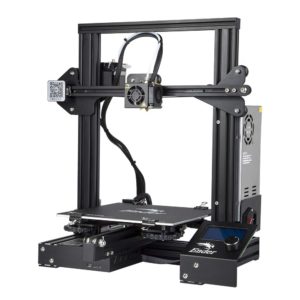
Creality Ender 3 is an excellent example of a company listening to customer feedback and making improvements to its product in accordance with that feedback. The Ender 3 has gone through many iterations that fixed many of its initial engineering mistakes. Today, this is one of the most affordable 3D printers that can deliver high-quality prints if it’s in the right hands.
The Ender 3 is an FDM printer that features a 0.4-millimeter extrusion nozzle that can extrude a variety of different 1.75-millimeter plastic filaments. For such an inexpensive device, the Ender 3 comes with a huge build area measuring 220 x 220 x 250 millimeters. With such a big build area you’ll be able to print objects of sizeable proportions if you have the patience to wait for them to be finished.
The Ender 3 is able to print layers as thin as 100 microns, which allows for some very detailed models to be printed. You can control the printing process by PC over a USB cable, or from G-Code files stored on a microSD card.
Unlike other 3D printers we’ve showcased in this article, the Ender 3 comes in the form of a semi-assembled DIY kit. The most complicated parts such as the hot end and print bed come pre-assembled. However, you will need to assemble the frame, add a power supply unit, mount the Y-axis, and complete the electronics cabling. To make things a bit easier on you, the printer comes with a large color instruction sheet that breaks the assembly process into twelve steps. The assembly process can take anywhere from 45 minutes up to two hours, depending on how pedantic you are. The assembly isn’t that complicated, and if you’ve ever built an IKEA shelf you won’t have problems with the Ender 3.
The assembly will be well worth it once you see the prints this model produces. The models are incredibly detailed, and you won’t be able to spot rough details until you look a bit closer.
Pros
- Affordable
- Incredible community
- Superb print quality
- Huge build area
Cons
- The bed leveling can prove difficult to some
- The assembly can put some people off this product
Bottom Line
The Creality Ender 3 is nothing short of simply amazing. This 3D printer makes high-quality printing affordable in a way that wasn’t possible a few years back. The fact that it comes in the form of a DIY kit isn’t even that bad. While assembling it, you will get a finer grasp of how the machine works and what are its limitations. Ender 3 is an excellent choice for those who are not afraid to take a deep dive into the world of 3D printing.
Conclusion
We hope that this article has managed to prove that 3D printing isn’t a thing exclusive to those who have deep pockets. 3D printing has come a long way from its inception, and as things are going, we wouldn’t be surprised if they become an integral part of every home.
What do you think about affordable 3D printers? Are they worth the hassle? Would you rather buy a pre-assembled model or a model that comes in the form of a DIY kit? Do you own any of the models showcased above? Let us know in the comments below!
YOU MIGHT ALSO LIKE:
6 Profitable 3D Printing Business Ideas
